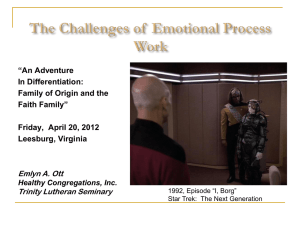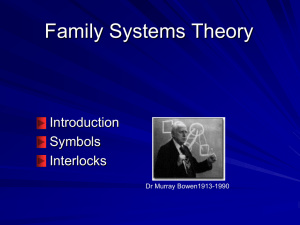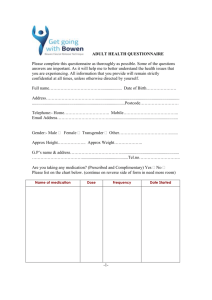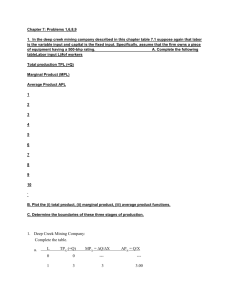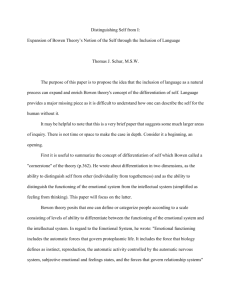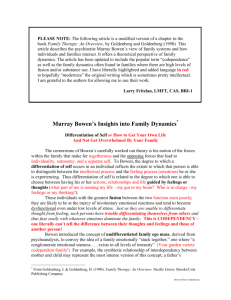Bowen Systems Theory handout
advertisement
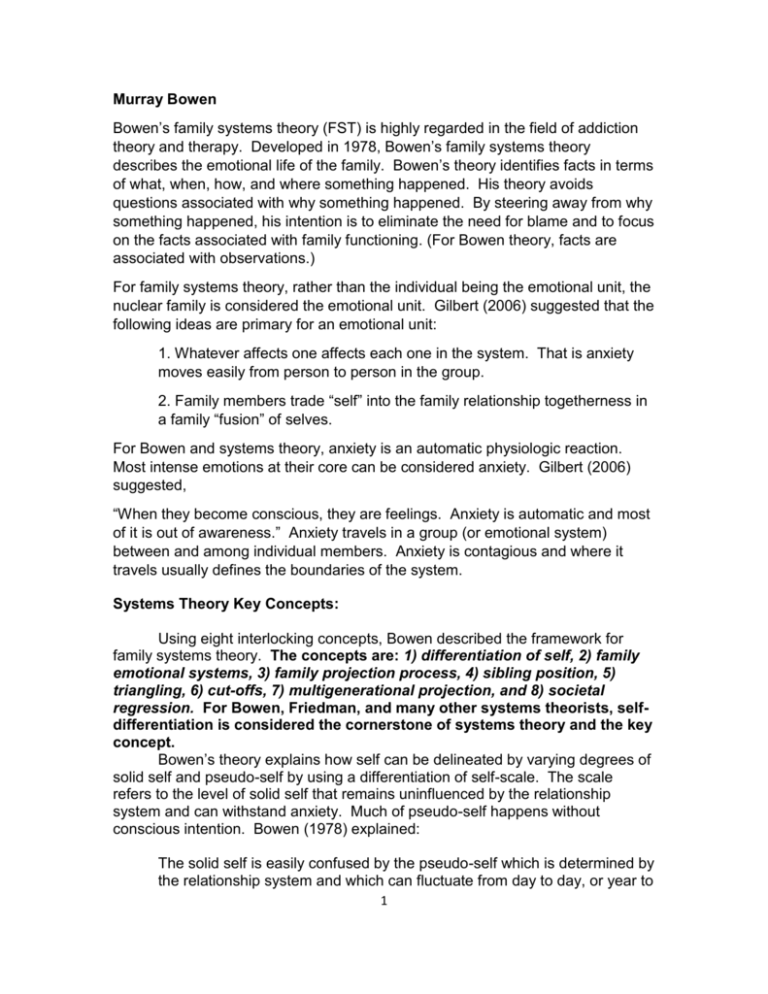
Murray Bowen Bowen’s family systems theory (FST) is highly regarded in the field of addiction theory and therapy. Developed in 1978, Bowen’s family systems theory describes the emotional life of the family. Bowen’s theory identifies facts in terms of what, when, how, and where something happened. His theory avoids questions associated with why something happened. By steering away from why something happened, his intention is to eliminate the need for blame and to focus on the facts associated with family functioning. (For Bowen theory, facts are associated with observations.) For family systems theory, rather than the individual being the emotional unit, the nuclear family is considered the emotional unit. Gilbert (2006) suggested that the following ideas are primary for an emotional unit: 1. Whatever affects one affects each one in the system. That is anxiety moves easily from person to person in the group. 2. Family members trade “self” into the family relationship togetherness in a family “fusion” of selves. For Bowen and systems theory, anxiety is an automatic physiologic reaction. Most intense emotions at their core can be considered anxiety. Gilbert (2006) suggested, “When they become conscious, they are feelings. Anxiety is automatic and most of it is out of awareness.” Anxiety travels in a group (or emotional system) between and among individual members. Anxiety is contagious and where it travels usually defines the boundaries of the system. Systems Theory Key Concepts: Using eight interlocking concepts, Bowen described the framework for family systems theory. The concepts are: 1) differentiation of self, 2) family emotional systems, 3) family projection process, 4) sibling position, 5) triangling, 6) cut-offs, 7) multigenerational projection, and 8) societal regression. For Bowen, Friedman, and many other systems theorists, selfdifferentiation is considered the cornerstone of systems theory and the key concept. Bowen’s theory explains how self can be delineated by varying degrees of solid self and pseudo-self by using a differentiation of self-scale. The scale refers to the level of solid self that remains uninfluenced by the relationship system and can withstand anxiety. Much of pseudo-self happens without conscious intention. Bowen (1978) explained: The solid self is easily confused by the pseudo-self which is determined by the relationship system and which can fluctuate from day to day, or year to 1 year. The pseudo-self can be increased by a congenial relationship and emotional approval and decreased by a negative relationship or disapproval. An index of pseudo-self is the degree to which people act, pretend, mask, and use external appearance to influence others and to feign postures that make them appear more or less adequate than they really are. 1) Self-differentiation describes the amount of self-identity or intentional response that remains as separate from other people, especially from the family of origin. Pseudo-self refers to the part of the person that is false self or acts in order to influence or be influenced by others. The pseudo-self tends to respond automatically to the actions or relationships of those around him or her. As solid-self increases, the individual tends to respond with greater self-awareness and an expanded ability to respond with intention—in other words with less fusion. Self-differentiation uses principles associated with fusion and anxiety. These principles are of critical importance for identifying well-being and the potential for success rate of therapy and adaptive functioning. Fusion can be described as the automatic emotional and intellectual connection within a person. A person with a high degree of fusion will likely have a lower sense of well-being. 2) Triangles describe how any three people interact. Bowen said, “A three-person system is one triangle, a four person system is four primary triangles, a five-person system is nine primary triangles, etc.: Differentiation of self and anxiety are used as two important variables that predict healthy functioning of any given triangle. For example, as selfdifferentiation increases the healthy functioning of the triangle increases and the relationships improve. However, as anxiety increases the healthy relational functioning of the triangle decreases and healthy functioning decreases as well. Bowen’s theory stresses the importance of remaining calm as tension increases. If one person can remain calm while remaining emotionally connected even under anxiety and stress within a triangle, the result is the anxiety of the other two people will likely subside as well. The adaptive functioning and well-being of the triangle can then be restored as anxiety decreases. Once one knows the triangle involved, is observing and relatively calm and objective, the anxiety will subside and healthy functioning will increase. From calm thoughtfulness and emotional neutrality, stay in contact with each of the other two angles of the triangle. Put them together in your thinking and talk. For example: “I know the two of you can solve this.” Remember, that in intense situations, the outside position is the preferable one. Asking questions about additional facts can be a good way of keeping that calm “outside” position. Bowen stressed the value of observation, “The therapeutic system is based on being able to observe accurately to see the part that self plays, and to consciously control this programmed emotional reactiveness . . . Observation is not possible until one can control one’s reactions sufficiently to be able to observe.” This reinforces the importance of self-differentiation and being able to manage our anxiety. The classic description is remaining calm and at the same time in good contact with the other two people in the triangle. 3) Nuclear family is the concept that describes the effects of the families of origin on a marriage. This concept involves identifying the range of selfdifferentiation and its effect on the future family. For example, if spouses have a higher level of self-differentiation, the likelihood of conflict in marriage will be decreased. If marriage partners have a lower level of differentiation of self from their families of origin, they are likely to have increased marital conflict. Thus, Bowen asserted that differentiation of self from family of origin is a key factor for healthy future marriages and partner relationships. 4) Family projection describes the projected problems that are passed along to the children from their parents. Again, self-differentiation is a critical factor in well-being and the overall health of the family. Parents who have a low differentiation of self from their families of origin tend to pass more problems along to their children. Parents who have a higher level of self-differentiation will project fewer problems along to their children and the family will be seen as having a higher level of adaptive functioning and greater well-being. 5) Multi-generational projection or transmission expands the idea of projecting or the passing on of problems from an inter-generational perspective. Self-differentiation continues to be a key factor for this concept in which family projection can be seen as affected by previous generations. For example, lower self-differentiation of grandparents can result in projected problems to their children. The projection process is then repeated by their children who become parents and continue the process of projecting problems. Thus, the grandchildren of the grandparents are ultimately affected by the lower self-differentiation of the grandparents. 6) Sibling position is the basic idea that birth position plays a role in the family. For example, the oldest child is considered to be the one who would be primary for picking up the projected family problems due to the birth order. 7) Emotional cutoff is the concept in which Bowen examined the unresolved attachment to the parents as a source of information. For Bowen, unresolved attachment to the parents is used as one predictor that has an impact on projection of problems to children. Some examples of emotional cutoffs include running away, withdrawal, denying, or isolating from parents. For example, Bowen’s theory stresses that the unresolved emotional attachment for a child who runs away is no different than the emotional attachment of a child who remains at home. 8) Societal regression is the eighth and final concept used by Bowen. He uses this concept to show how the effects of anxiety appear in our society as well. This concept is further explored in Friedman’s theoretical framework of systems theory.

